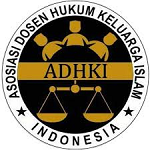Determination Of Child Care Rights Between Biological Parents And Adopting Parents (Analysis of Judgments of Pahang Sharia High Court and Selangor High Court)
Penetapan Hak Asuh Anak Antara Orang Tua Kandung Dengan Orang Tua Angkat (Analisis Pertimbangan Hakim Mahkamah Tinggi Syariah Pahang Dan Mahkamah Tinggi Selangor)
DOI:
https://doi.org/10.22373/hadhanah.v3i2.2750Keywords:
Child Custody, Adoptive Parents, Judge's ConsiderationAbstract
Adoption of children is regulated in the Deed of Registration of Appointment 1952 (Deed 253) for Muslims and non-Muslims and the Deed of Adoption 1952 (Deed 257) for non-Muslims. Among the cases involving the struggle for custody is the one that occurred at the Pahang Sharia High Court, in which the judge handed over a child to his biological parents while the child had been registered under the Deed of Registration of Appointment 1952 (Deed 253). Then, in the case at the Selangor High Court, the judge handed over custody rights to the adoptive parents while the adoption registration was invalid. There are two formulations of the problem in this thesis. Firstly, what are the considerations of the Pahang Sharia High Court judges in determining child custody between biological parents and adoptive parents? Second, what are the considerations of the judges of the Selangor High Court in determining child custody between biological parents and adoptive parents? This research uses the juridical-normative method and case studies. Data collection is also done with literature and documentation. The results of the study show that first, the consideration of the judges of the Pahang Sharia High Court in determining child custody of their biological parents is because the judge looks at their efforts to get their child back and they have full rights to the child. Second, the consideration of the judge of the Selangor High Court in determining child custody of the adoptive parents is important because the judge stated that the main thing is what is best for the child, and the child's biological parents also have several obstacles to looking after the child. Custody is closely related to the interests of the child and the guardians, if there is an imbalance in custody, then the rights and interests of the child need to take precedence over the interests of the guardians.
References
Abdullah Bin Abdurrahman Al Bassam, Syarah Bulughul Maram, jilid 5, Jakarta: Pustaka Azzam, 2006.
Ahmad Arshad & lwn Mohd Jamal Bin Mat Jamin, Shariah Law Journal (CLJ), 2006.
Al Imam Muslim, Terjemahan Shahih Muslim, Terjemah: Ma’mur Daud, Jilid 1, Selangor: Klang Book Centre.
Asbiran Yaakub, Hadis Empat Puluh, Fathoni: Bin Halabi, 1968.
Aulil Amri, Perbandingan Hukum Keluarga di Dunia Islam, Banda Aceh: Ar-Raniry Press, 2021.
David Werner, Carol Thuman, & Jane Maxwell, Apa Yang Anda Kerjakan Bila Tidak Ada Doktor. Yogyakarta: C.V Andi Offset, 1980.
Enakmen 3 Tahun 2005 Enakmen Undang-Undang Keluarga Islam Negeri Pahang.
Enakmen 4 Tahun 2005, Enakmen Keterangan Mahkamah Syariah 2005.
Engku Muhamad Tajuddin Engku Ali, “Kelemahan Akta Pendaftaran Pengangkatan 1952 (Akta 253) dan Enakmen Pentadbiran Undang-undang Keluarga Islam Negeri dalam menangani Keperluan Pengangkatan”. Jurnal Islam, 2011.
H Miftah Faridl, Rumahku Syurgaku Romantika dan Solusi Rumah Tangga, Jakarta: Gema Insan, 2005.
Ibnu Katsir. Tafsir Ibnu Katsir, Jakarta: Pustaka Tafsir Ibnu Kathir.
Imam Bukhari. Terjemahan Hadis Shahih Bukhari, Jilid 4, Selangor: Klang Book Centre, 2009.
Jabatan Peguam Negara, Akta Mahkamah Kehakiman 1964 (Akta 91), Kuala Lumpur: Percetakan Nasional Malaysia, 2006.
Jabatan Pendaftaran Negara Malaysia. Diakses melalui: https://www.jpn.gov.my/soalan-lazim/anak-angkat/#1458871827116-93eee0c6-a15f, tanggal 29 Oktober 2020.
Jawatan Fatwa Majlis Ugama Islam Singapura, “Malay Fatwa Batasan Aurat Keluarga Angkat”. Diakses melalui: https://www.muiz.gov.sg/officethemufti/Fatwa/Malay-Batasan-Aurat-Keluarga-Angkat, pada tanggal 22 November 2020.
Lembaga Penyelidikan Undang-Undang, Perlembagaan Persekutuan, Selangor: International Law Book Services, 2014.
Md Zawawi Abu Bakar & Chan Cheong Chong, “Amalan Pengangkatan Kanak-Kanak di Malaysia: Satu Analisis Perbandingan”. Jurnal Pembangunan Sosial, Jilid 21, September 2018.
Muhaimin, Metode Penelitian Hukum, Mataram: Mataram Universiti Press, 2020.
Muhammad Ibn Ahmad Al-Qurtubi, Tafsir al-Qurtubi, Jakarta: Pustaka Azzam.
Muhammad Nashiruddin Al Albani. Shahih Sunan Ibnu Majah, Terjemah: Ahmad Taufiq Abdurrahman, Jilid 2, Jakarta: Pustaka Azzam, 2007.
Mustofa al-Khin, Mustofa Al-Bugho, & Ali Asy-syarbaji, Kitab Fikah Mazhab Syāfi’ī. Kuala Lumpur: Pustaka Salam Sdn Bhd, 2014.
My Government, Mengurus Institusi Keluarga. Diakses melalui: https://www.malaysia.gov.my/portal/subcategory/1654?language=my, tanggal 17 Maret 2023.
Nur Zulfah Md Abdul Salam “Asas Pertimbangan Dalam Penghakiman Hadhanah: Analisis Terhadap Kes-Kes Di Mahkamah Syariah”. 4th Muzakarah Fiqh & International Fiqh Conference (MFIFC 2018), 17 Oktober 2018.
Sayyid Sabiq, Fikih Sunnah, Jakarta: Cakrawala, 2008.
Siti Suhaila Mohd Yusop. “Kes-Kes Hadhanah”. Jurnal Hukum.
Syamil Ridhwan, “Perlindungan Anak Tak Sah Taraf”. Malaysia: Universiti Malaya. 2019.
Tang Kong Meng v Zainon Bte Md Zain & Anor, The Malayan Law Journal, 1995.
Undang-undang Malaysia, Akta Pendaftaran Pengangkatan 1952 (Akta 253), Kuala Lumpur: Pesuruh Jaya Penyemak Undang-undang, 2009.
Undang-Undang Malaysia, Akta Pengangkatan Anak 1952 (Akta 257), Kuala Lumpur: Pesuruh Jaya Penyemak Undang-Undang, 2009.
Wahbah Az-Zuhaili, Fiqih Islam Wa Adillatuhu, Jakarta: Gema Insani, 2016.
Wahbah Az-Zuḥailī, Tafsir Al-Munir, Jakarta: Gema Insani Press, 2001.
Zanariah Noor & Anor, “Pengangkatan Anak Serta Implikasinya terhadap Nasab, Hadhanah, Nafkah dan Pusaka Dalam Undang-undang Keluarga Islam” Jurnal Perspektif: Special Issue 1, 2017.
Downloads
Published
How to Cite
Issue
Section
License
Copyright (c) 2023 Nur Fatin Adila Binti Idereh

This work is licensed under a Creative Commons Attribution 4.0 International License.

















